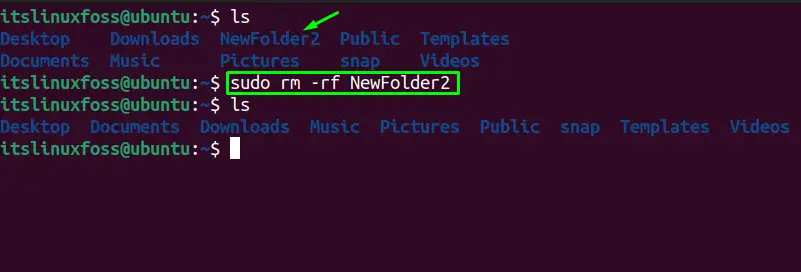A user with administrative access who can remove, add, or updates the system files is called a sudo user. To delete a file or multiple files, we use the sudo rm command and remove a folder forcefully & recursively in Ubuntu 22.04, the “sudo rm -rf” command is used.
This post will elaborate on what is sudo rm -rf in ubuntu 22.04 with its usages and how we can securely use this command.
What is sudo rm -rf in Ubuntu 22.04?
First, we will check the functions of the main command “rm”, then its two flags, “-f” and “-r”. In the end, we will discuss using the “sudo rm -rf” command and how we can securely use this command. This section’s hierarchy is given below:
- What Does “rm” Command Do?
- What Does “rm -f” Command Do?
- What Does the “rm -rf” Command Do?
- What Does the “sudo rm -rf” Command Do?
Lets’s start with the main “rm” command.
What Does “rm” Command Do?
The “rm” (remove) command is utilized to delete or remove files from a directory. To check the files and verify the removal of files from a directory, we use the “ls” command that lists all the files in a folder. To remove a file named “newFile”, use the following command:
$ rm newFile

The output shows that the file named “newFile” has been removed from the system.
What Does “rm -f” Command Do?
If you want to delete a file “read-only” privileges when you try to delete a file (having “read-only” privileges) with the “rm <file-name>” command, it will ask for “permission” as follows:
$ rm newFile

To avoid the above-stated permission, the “-f” flag of the “rm” command can be used. To remove a file named “newFile” with “read-only” permission, use the following command:
$ rm -f newFile

What Does the “rm -rf” Command Do?
The files can be deleted with the “rm” and “rm -f” commands, but if you want to delete a folder using these commands, it will show the below error:
Error: rm: cannot remove ‘newFolder’: Is a directory.
$ rm newFolder
$ rm -f newFolder

To delete a folder/directory in Ubuntu 22.04, we need to use “rm -r” with the folder name. To delete a folder named “newFolder”, use the following command:
$ rm -r newFolder

The error-free output shows that the folder named “newFolder” is successfully deleted.
Now, we have seen the particular uses of the “rm”, “rm -f”, and “rm -r” commands, so where does the “rm -rf” command is used?. If we have a directory/folder in which we have a file with “read-only” privileges, we can not delete that directory using the “rm -r <folder-name>” command. It will ask for permission as shown below:
$ rm -r NewFolder2

What Does the “sudo rm -rf” Command Do?
To delete a folder having “read-only” permissions, we must use the “sudo rm -rf <folder-name>” command where you have “administrative/sudo” privileges to force delete that folder recursively. To delete a folder named “NewFolder2”, use the below-written command:
$ ls
$ sudo rm -rf NewFolder2

The output verifies the deletion of the folder with a file having “read-only” privileges.
How to Securely Use the “sudo rm -rf” Command?
The “rm -rf” command deletes the directory recursively and forcefully, so use it carefully while executing with the home “/” option that can delete the “root” directory. When you run this command, it will give you a warning “rm: it is dangerous to operate recursively on ‘/,” as shown below:
$ sudo rm -rf /

Don’t play with this command, as it can lead to the removal of the “root” user from the system. If you intentionally want to delete the root directory, use the “$ sudo rm -rf / –no-preserve-root” command to continue deleting the root user.
That’s the end of this guide.
Conclusion
The “sudo rm -rf” command in Ubuntu 22.04 is used to delete directories recursively and forcefully. The command “rm <file-name>” deletes a file from the folder, while the command “rm -f <file-name>” is used to delete a file with “read-only” privileges. Moreover, the “rm -r <folder-name>” command deletes a directory, while the “sudo -rf <folder-name>” deletes a folder having the “read-only” privileges file. Never use the command “sudo rm -rf /” unintentionally, as it will delete the “root user” from the system. This post has provided a detailed demonstration of the “sudo rm -rf” command in Ubuntu 22.04.
